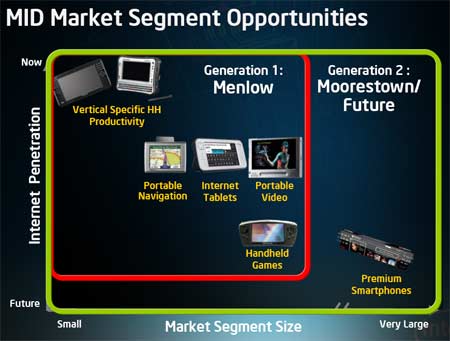Intel Fires Up New Atom Processors
Conclusion: A great chip and a market strategy that raises questions
We have seen Silverthorne so far on paper, talked with the engineers behind the product and saw it running in a lab environment. There is a big vision behind this chip, one that could reach far beyond the MID and enable a new generation of notebooks and even desktop computers that will be capable of running all the basic tasks in a much more power efficient manner than what we have today. In fact, I can't wait to get one of these systems into my hands.
There are a few drawbacks of this first-generation design, mainly the huge SCH and the power consumption of these devices, which may limit the usability of this product category initially. If you are interested in buying on these MIDs, we suggest that you don't buy them over the Internet, but actually go into a store and play with them so you get a feel how heavy and bulky they are.
The success of Atom is not a given in our opinion - and this is not just because ARM is dominating this segment now (and is unlikely to just watch Intel take away market shares) and the fact that Intel is in this game alone, without the support of another major technology partner such as Microsoft. To us, it looks like the marketing department may be shooting itself in the foot.
Since the very first time Intel began talking about Silverthorne, the company highlighted the fact that this would be one cheap processor, the cheapest one since the 286. In fact, we checked with our sources again earlier today and we received a confirmation that the production cost is somewhere in the $6 - $8 neighborhood.
The cheap processor claim raised expectations that Intel would roll out a processor that would also be cheap to purchase. But what was announced today is not really cheap. $45 for the entry-level platform is on the high-end of analyst estimates and we have no idea what exactly justifies $160 for the 1.86 GHz version. The same money could buy a 2.66 GHz Core 2 Duo E8200 CPU ($163). Either there is a really high demand for Windows Vista MIDs or Intel simply wants to limit Microsoft's access to this market segment.
There is no doubt that prices for Silverthorne are artificially high right now. They will have to come quite a bit, if Intel is serious about establishing a new mass market product category.
Buying a first-generation MID means that you will have to pay a premium for the privilege of owning a new communication device. But if you can also accept the low battery life and bulky form factors, you are likely to enjoy your MID.
Get Tom's Hardware's best news and in-depth reviews, straight to your inbox.
All other users may want to wait until 2010: Moorestown will bring much smaller MIDs and more capable smartphones for less than $500. In our opinion, this will be the device generation consumers are actually looking forward to.
{gallery}200804013{/gallery}
Current page: Conclusion: A great chip and a market strategy that raises questions
Prev Page Intel Fires Up New Atom Processors
Wolfgang Gruener is an experienced professional in digital strategy and content, specializing in web strategy, content architecture, user experience, and applying AI in content operations within the insurtech industry. His previous roles include Director, Digital Strategy and Content Experience at American Eagle, Managing Editor at TG Daily, and contributing to publications like Tom's Guide and Tom's Hardware.
